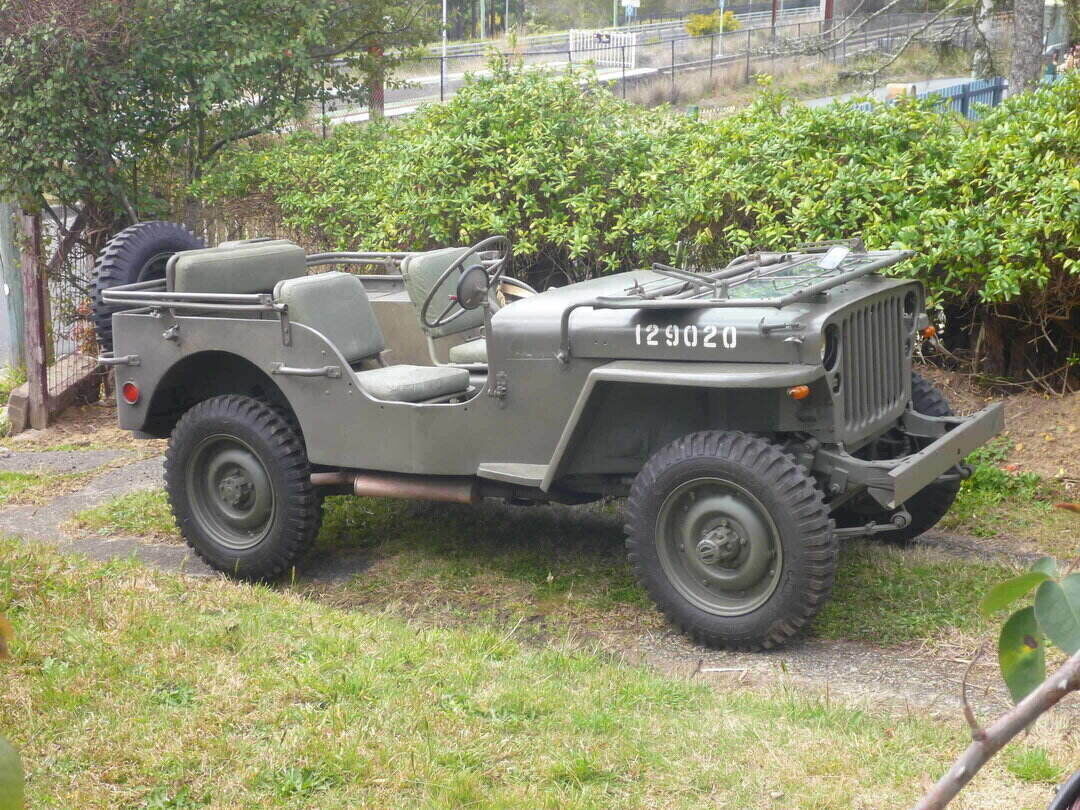
My RHD Jeep is a combination of Willys and Ford parts.

My RHD Jeep is a combination of Willys and Ford parts.
It is now September 2025, and having been
part of the vintage car world for 23 years, I had seen WW2 Jeeps at various
display days. They also featured in war time electronics magazines, in
articles and advertisements. Bit by bit the seed was sown...
Up to this point, I had not taken a lot
of notice of them, since I'd never really been interested in 4WD vehicles,
and I was not too keen on the left hand drive aspect.
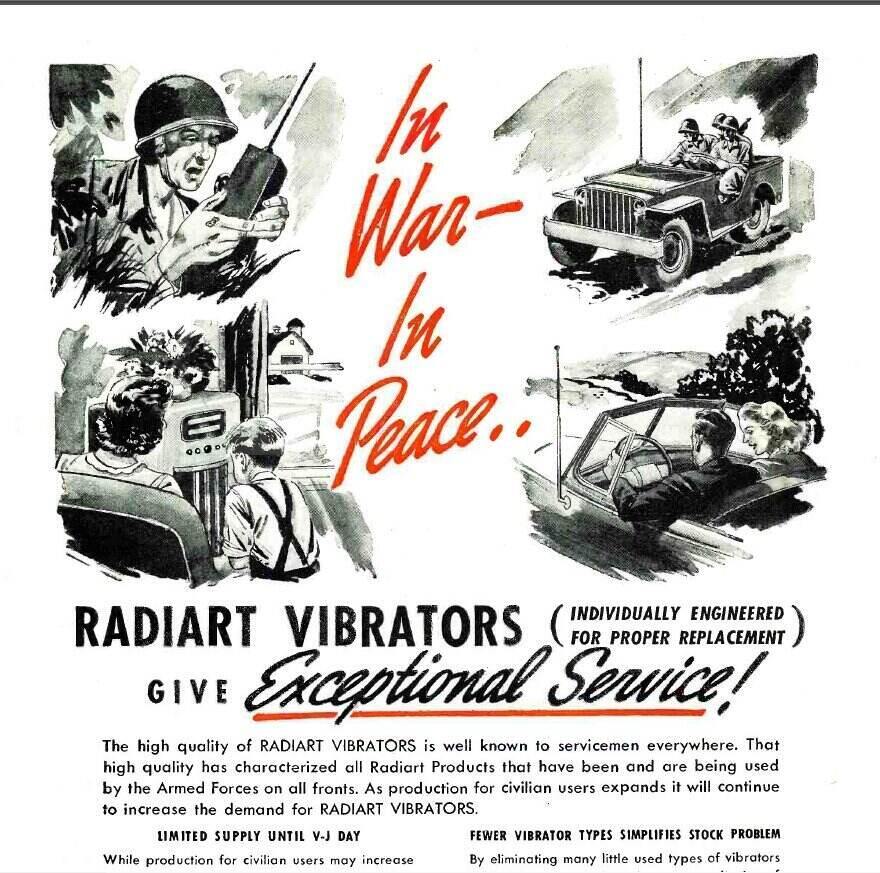
Wartime ad which I'd recently used in my "Study of the Vibrator Power Supply" series - a subconscious part of connecting with the Jeep perhaps?
A few years ago, my mother casually mentioned
she had learned to drive in a Jeep, in post-war PNG, where my family lived
in Port Moresby. I had also been looking up vacuum wipers for the Model
T, which led me to a You Tube channel created by Greendot 319.
Apparently, some WW2 Jeeps were equipped
with vacuum wipers - and I'd also seen them for sale on eBay sold for Jeeps.
The point here is, as Greendot 319 talked about the wipers, I was noticing
other things about the Jeep. Things I liked - the 6V electrical system,
and the simplicity of the whole design, But I thought, I can't afford it,
and I've got no space.
Early 2025, and there happened to be a
"Jeep in a Crate" video on You Tube. The fabled story of WW2 Jeeps in crates
lives on to the present day, and they are actually being made, along with
all the other repro parts. Just out of curiosity, I looked up the service
manual for the WW2 Jeep. It clicked with me straight away. Just like the
Model T, this is how I would design it. The freedom from unnecessary parts
was there; good service access, and use of normal tools to work on it.
Like early Fords, parts are prevalent, and if anything, the supply is actually
better. For me, this is one of the most deciding factors in considering
a vintage car.
I couldn't help but now learn about them,
and how much they sold for in the present day.
About 647,000 Jeeps were made from 1941 to 1945. They were made by Willys Overland as model MB, and also Ford, as model GPW. The parts were interchangeable, and for the most part looked exactly the same regardless of brand. There were a few differences with some parts, but they were still interchangeable. About 15,000 Jeeps were imported by the Australian Army, and it seems a considerable number have survived. There is a ton of information on the internet about WW2 Jeeps, if one wishes to learn more of their story.
Buying a Jeep.
I quickly learned that in Australia at
least, a WW2 Jeep is not difficult to get. There are always a few for sale
at any given time. It really comes down to price then. At the upper end,
expect to pay around $40,000 for a museum quality Jeep with matching numbers,
and a documented history. A 'typical' Jeep goes for around $30,000 - something
that is a recent or older restoration, complete, drivable, and possibly
registered. Below this are unfinished project Jeeps, which I've seen start
at around $12,000 and heading upwards to around $25,000, depending on how
much still needs to be done.
What of the "where to put it" problem? Well, I spent a considerable amount of time working out various scenarios and doing measurements. My garage is 12 m long. The Hilux is about 5.2 m, and both the Jeep and Model T are about 3.3 m long. It seemed they should all fit inside the garage. So having calculated that, I happily exclaimed, "I can have a Jeep!"
Right Hand Drive Conversions.
Jeeps, being of U.S. manufacture were,
not surprisingly, only made in left hand drive. Australia has always had
an aversion to LHD vehicles, and when Jeeps were released onto the civilian
market post war, many were converted to RHD in order for registration.
Victoria was the most strict state about it, insisting on conversion.
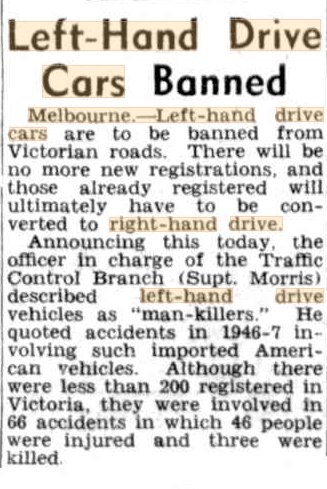
Banned in Victoria.
NSW was more lenient, in that Jeeps were
excepted, provided a suitable signalling device was fitted.
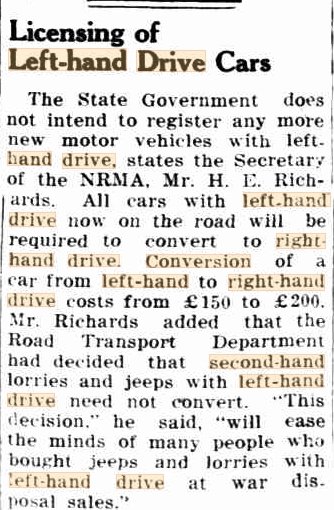
LHD Jeeps permitted in NSW.
There was no official kit for the RHD conversions,
which meant all kinds of modifications were done of varying quality. I
had seen some of the Jeeps for sale were RHD converted.
In the modern day, LHD vehicles are now
permitted, once they are 30 years old. I had wondered what it would be
like to drive LHD, and in RHD traffic. Logic told me that it shouldn't
be a problem in a Jeep, since vision is unobstructed, compared to a closed
car with numerous pillars.
Although, I wouldn't recommend doing a RHD conversion on a Jeep, or any other historic vehicle in the modern day, the fact is that RHD conversions were a government mandate at the time. Convert your vehicle or you can't drive it, is what it came down to. In that regard, I see such conversions as part of Australian motoring history. Mine was very well done; I like it, and won't be converting it back to LHD. However, I can fully understand the desire for those with a "hack job", or wishing to restore to original, to convert it back. RHD conversions are unique to Australia, and I think some of them should be preserved to show what the policy once was.
First Test Drive.
The first Jeep I looked at was located
near Queanbeyan. It was for sale for $30,000 and was recently restored.
The photos looked good, and it would appear I wouldn't really have to do
anything to it - except convert it back to 6V. (Like the rest of the vintage
car world, Jeeps often get the dreaded "12V conversion"). The engine had
been completely rebuilt, along with new brakes, etc. It was being sold
as an original 1943 Willys MB, except for the 12V conversion, a few minor
cosmetic things, and freewheeling hubs. The latter were one of the things
that attracted me to this Jeep.
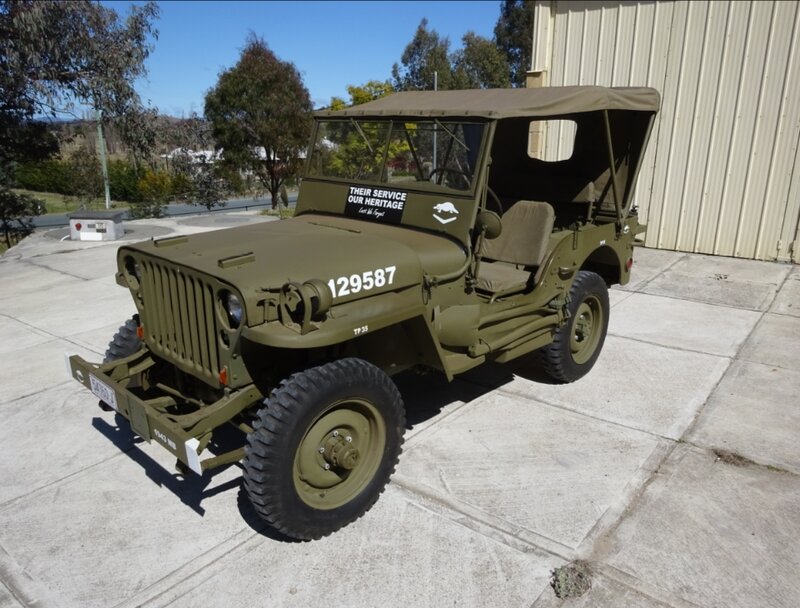
Nice Jeep, but the "where to put it" problem was playing on my mind
at this stage.
In April 2025, off I went to have a look.
It was located in a rural estate; presumably a recently subdivided farming
property. It was a perfect area for test driving with no other traffic
around. First the owner took me for a drive in it. The amount of low end
torque was immediately obvious. Rather disconcerting, was that as a passenger,
there was nothing to hold onto except the handle on the side of the body.
The seats are very basic canvas cushions on a metal base. It was then my
turn. It was a real surprise how I took to driving LHD. It felt completely
normal changing gears with the right hand. The shift pattern is the standard
three speed floor shift. That means reverse is where first gear is in a
four or five speed car. That was the only real point of confusion. At one
time, I accidentally took off in second gear, but there were no signs of
the engine struggling. The low end torque is that good.
The brakes were different to anything
I've driven before, in that there was little pedal movement before the
brakes were applied. The braking didn't feel definite either, although
it did stop. The hand brake barely worked. That's something that Jeeps
have a reputation for, but talking to a GPW owner, he explained it's due
to incorrect adjustment. I'd tend to agree, since I find it hard to believe
that two reputable car manufacturers would make something in such quantity
with a hand brake that didn't work. The carburettor had an idling problem.
Sometimes it would idle, sometimes it wouldn't. Several times it stalled
whilst idling when I drove it.
On a positive note, after that drive,
I had no problem at all with LHD.
The electrical system was completely non original. It was now 12V, but unfortunately the starter motor was still 6V. The grinding of the Bendix when the starter was used was extremely disconcerting.
The generator had been replaced by a 12V
one out of a late 50's/60's Holden. The original regulator had been gutted,
and I was told it now contained various relays. Underneath it was mounted
the 12V regulator. When I enquired if the owner had the 6V parts, he said
no, implying they had been disposed of, never to be used again.
I've given up trying to convince people
that 12V is unnecessary, and damaging to the starter motor, so I kept quiet
and mentally worked out what parts I'd have to source, to restore it to
the proper voltage. Indicators had been fitted, which is essential in the
modern day - to drive in normal traffic anyway. Legally, they're not required,
but modern drivers don't know hand signals. The indicator switch had been
taken from another vehicle and modified.
I was a bit concerned about the condition
of the tyres. Apparently, the owner liked to collect second hand tyres.
In fact, he'd made up a special tool to get the difficult ones off their
rims. The tyres on this Jeep had fine cracks in the side walls, which I
thought a were a bit worrying.
The original fuel filter mounted on the
firewall, and its fuel lines, had been taken out of service. Instead, a
plastic inline type had been installed. Also, a drip feed for upper cylinder
lubricant had been installed. After all that, I'm not sure "original" was
quite the correct description, not that I cared one way or the other.
However, they were all things I could
deal with, and didn't factor into my buying decision. It's a fact that
any second hand vehicle, "restored" or not, will need things doing to it.
So off home I went on a high. I liked the Jeep and felt connected with it. Alas, there was still doubt of where to put it. I thought about garage extensions and a carport. While measurements seemed to indicate my three vehicles should fit, it was too close for comfort. Once I actually saw the Jeep in real life up close, it looked larger than I had imagined. While I could park the Hilux outside, I was reluctant to do so. I was happy with the Jeep, but hesistant about the practicalities of where to put it. Anyway, I thought I should let the owner know that I wouldn't be able to buy it at this stage. It would be unfair to leave him waiting for days, while I tried to work something out. He was not interested what I had to say, so I didn't get a chance to tell him I'd buy it if I could work out a solution. As it happened, it sold about a month later, and I knew more would turn up. It was a good learning experience in any case.
At the Campelltown Steam Museum open day, May 2025, there were some Jeeps on display. I knew they'd be there, since they had always been there in the past, so was especially keen to go this time.
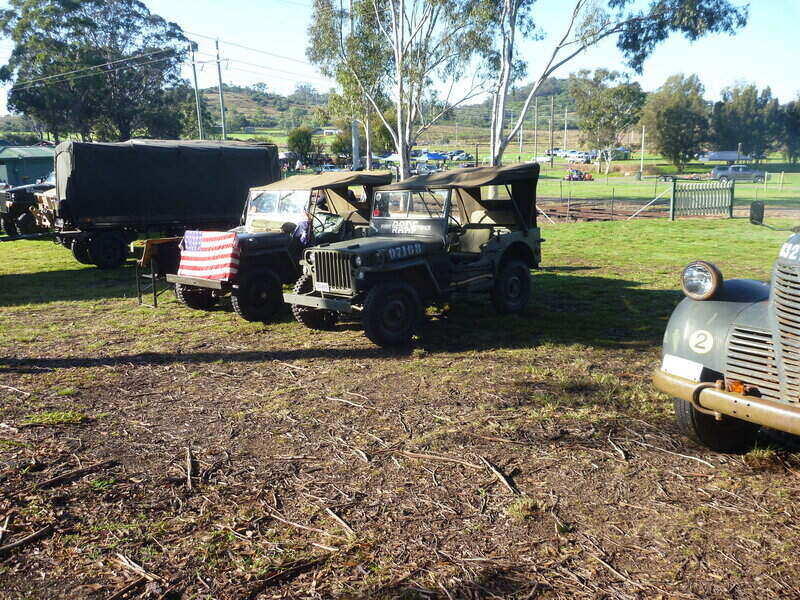
Display day at the Campelltown Steam Museum (May 2025).
There were three Jeeps for the display, among the other military vehicles. I spent quite a lot of time looking at them and talking about them with their owners. One of the guys was quite interested in my Model T, so we had a long conversation about each others vehicles. I learned some useful things about Jeeps from him. Even so, at the end of the day, I was still convinced that it was impractical for me to own one. No matter how much I tried, I couldn't get Jeeps out of my head...
The RHD Jeep.
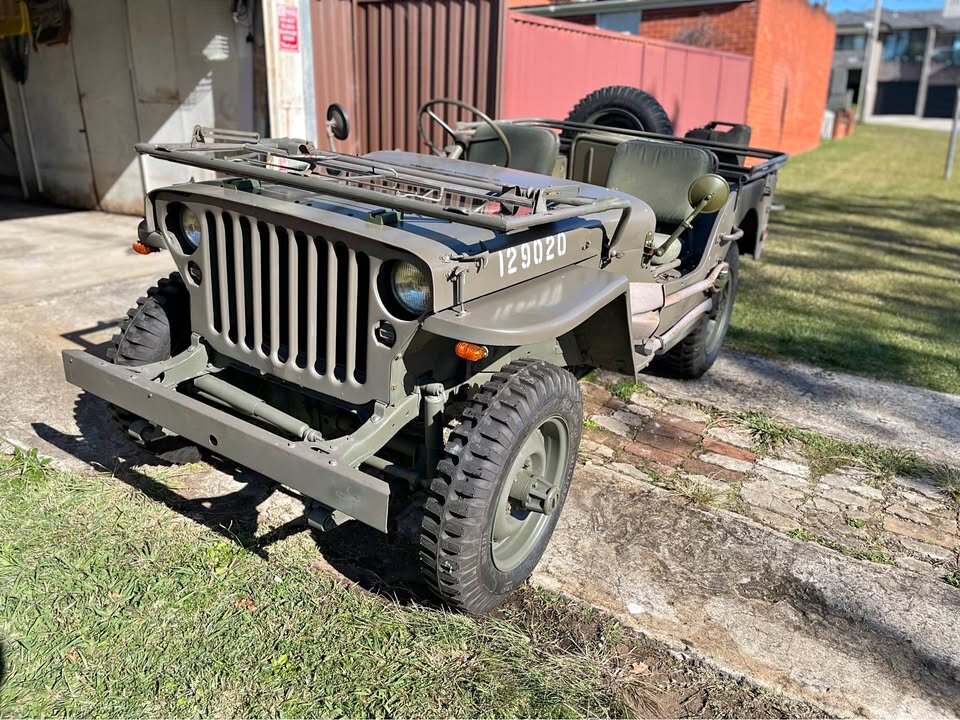
How could I resist this? The price was right, too!
I had seen it advertised, and a couple
of my friends had also alerted me to it. Somewhere in Sydney was a RHD
Jeep for $24,500. My initial reaction was "that's a RHD hack job", and
no way would I touch it. At this stage of my Jeep journey, all I'd heard
about RHD conversions was mostly negative. It seemed that many people in
the Jeep world didn't like them, and in their opinion, it devalued them.
This particular Jeep also had no glove box which I thought was part of
the hack job.
But, having given up on the previous Jeep,
I had another look at this one. Maybe it wasn't so bad after all...it was
still 6V and had freewheeling hubs. It was also a lot closer to home. Strangely,
it had no blackout driving light. The quirky nature started to grow on
me. This Jeep had individuality! Then I realised something else - the lack
of glove box could actually be correct. The important fact here was the
tub had the Willys logo on the back. This was only done up until early
1942, and as it happened, the first generation of Willys bodies (the so
called "Slat Grille" version) up until late 1941 didn't have glove boxes.
I learned also that blackout driving lights were not always fitted to earlier
Jeeps, or those not used for combat.
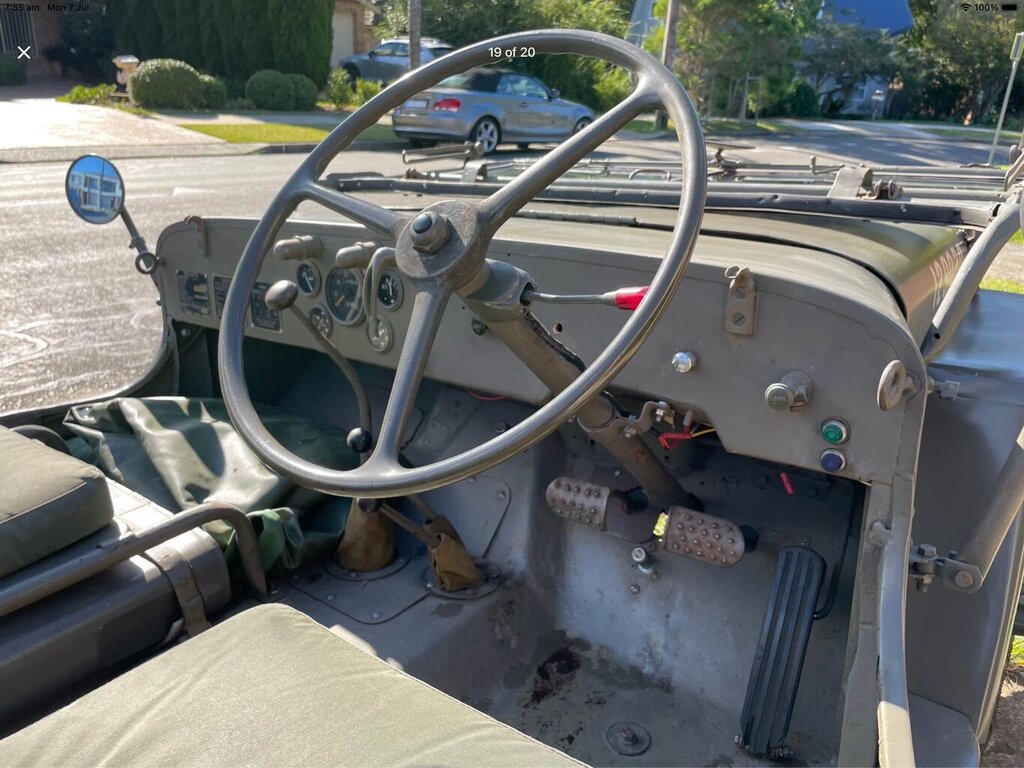
Upon closer inspection, the dash conversion to RHD was actually
very good.
I had mentioned to my car friends I'd been
interested in getting a Jeep, but the "where to put it" problem was making
it difficult. Around this time, I was talking about it to one of them,
and he said, "Is that all you're worried about? You should follow your
dreams!"
That stuck in my mind, and I thought it
about it - what was the problem really? Well, I could simply park the Hilux
in the driveway. After all, prior to owning the Model T, I didn't even
have a garage, and for my entire car owning life until then, they were
always outside. I think I had just been spoiled for the last 20 years having
a lock up garage. And there was still a possibility all three might
fit in the garage, despite my pessimistic calculations. But importantly,
I could have a Jeep if I wanted to. The room was there on my property.
Having had sense talked into me, I decided to proceed, and look into the
RHD Jeep.
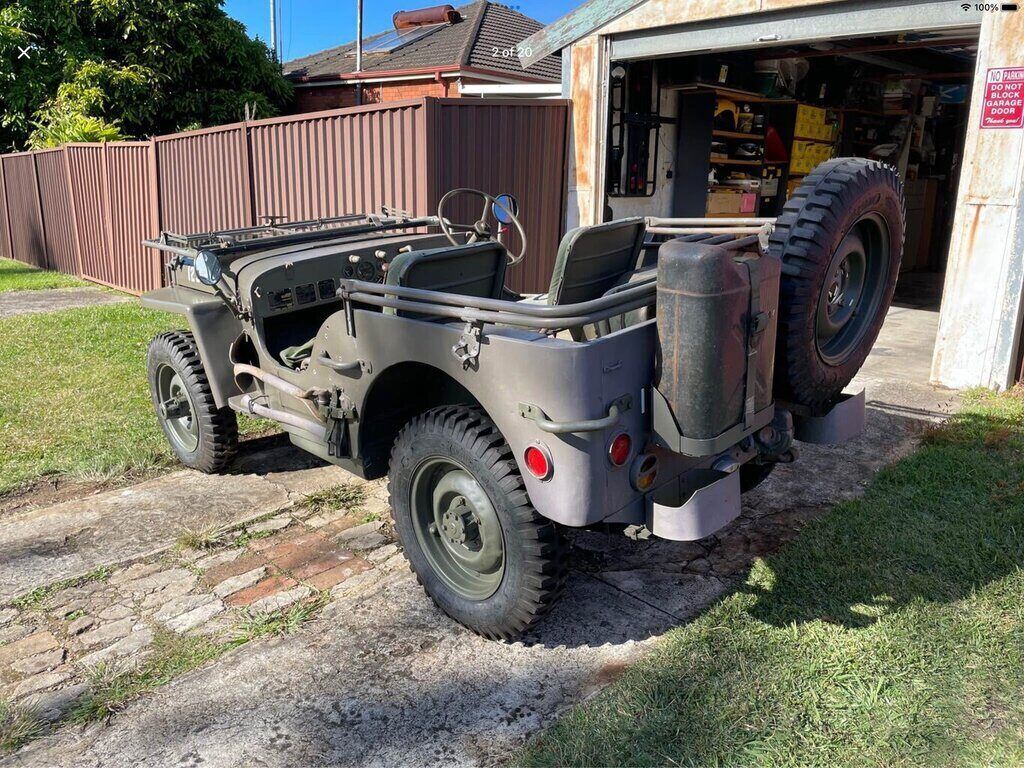
The colour was a bit odd, but added to the character.
It was a project and had a lot done to
it. It was a mixture of Willys and Ford parts. The body was Willys, as
was the engine, and the chassis and running gear was Ford. It had two previous
known owners; one from Victoria (where the RHD conversion was done), and
one in QLD who never registered it. The current owner had attempted to
register it, but it failed on a few minor things. A house move got in the
way, and nothing further was done. By the look of it, it was ready to drive
away. The owner mentioned in the ad that the inspector for registration
said that it was one of the best RHD conversions he'd seen. And let's be
realistic, RHD is better for built up traffic. The RHD devaluation in price
was also in my favour. The fact that it was "devalued" was irrelevant to
me - I'm not in this hobby for profit.
I wasn't after a matching numbers museum
piece anyway. I just wanted a drivable Jeep. The saving of $5500 over the
previous Jeep was very much in its favour too - and I didn't have to convert
it back to 6V! I made up my mind - if the steering was good, I'd buy it.
I contacted the owner, but had to wait
about a month for him to return from overseas. In the meantime, I kept
looking at the photos and imagining what it would be like when I actually
drove it.
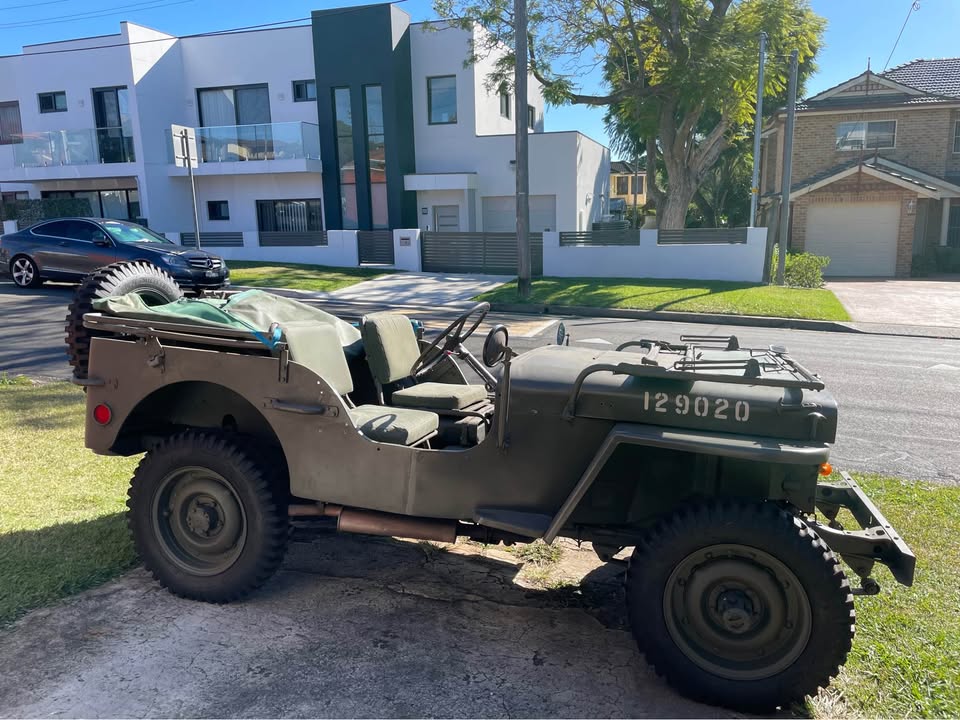
This Jeep had character. I had to check it out.
The owner was really friendly, and genuinely loved this Jeep. It was apparently due to wife pressure that he was selling it. He was great to chat to, and told me all about his work on the Jeep. He said he hadn't been able to start it for a year, and asked if I might be able to get it going when I came for a look.
The day came, and I was off to the Sydney
suburb of Epping. As soon as I saw the Jeep I connected with it. I knew
exactly where to look and what to do. First was to check the ignition.
6V was present at the coil, and a spark occurred when the points were opened.
That left fuel - so I trickled some petrol
down the carby, and it burst into life - for a few seconds. Evidently,
no fuel was getting into the engine, even though the fuel pump was primed.
Opening the float chamber revealed it was totally dry. It didn't take long
to find a blockage at the inlet to the float valve. After that was cleaned
out, it started easily and ran really well. It idled perfectly too! I later
learned it had a Stromberg carburettor off a 60's Holden. Well, if it worked
that well, it would definitely be staying, if I bought the Jeep.
I spent about 20 minutes doing tight three point turns in the cul-de-sac. The steering was perfect - exactly like the LHD Jeep. There was just one thing - the steering wheel was against my thighs. Now, with the previous Jeep, the owner had raised the angle of the steering column so it wasn't a problem with that one. I could live with it if I really had to, however. (Subsequently, I discovered once I began work on the Jeep, that the steering column had been shortened). Anyway, I said I'd get back to the owner in a few days and let him know. There's two options with the steering; 1) raise the column angle, or 2) get a smaller steering wheel. The original steering wheels are 17" diameter, but recently a repro of 15" has become available for just this problem. Another thing I needed to check was the dimensions of the Jeep - would it actually fit into my garage? It would be an awful thing to get it home and find otherwise!
So, I went back the following weekend with a tape measure. Yes, a smaller steering wheel would solve the problem, if it was not possible to raise the steering column angle, and yes, it would fit in my garage. Until now I'd been hesitant to commit to it, but as I sat in it a calmness came over me, and I knew it was for me. I said I'd take it. I transferred a deposit over, and took home two crates of new parts, and five old tyres with two rims - one a combat rim, and the other maybe from a CJ.
The next question was how to get it home. In theory, it should be possible to drive it on an Unregistered Vehicle Permit. However, I was not experienced with driving Jeeps in traffic. The possibility of another fuel blockage was there, since it hadn't been run for a year. Ultimately, getting a trailer was the less risky option. The problem here is relying on someone else to tow it, since I don't have the experience. One friend said he'd do it, but pulled out a couple of days before due to illness. A short panic ensued, since I'd already booked the trailer, but then remembered another car friend who had the right towing vehicle and experience. And he also had the tie down straps - necessary, since these don't come with the trailer. Crisis averted at the last minute!
Pickup Day.
Next Saturday was pickup day. The intention
was to drive the Jeep onto the trailer. Unfortunately, the owner used too
much choke. By the time I noticed the black smoke and advised him to push
in the choke, it stalled from flooding, and would not restart. So, we rolled
it down the drive way and winched it on. (Subsequently, it turned out this
carburettor required no or very little choke for starting).

Loading onto the trailer.
The trip back was uneventful, and the Jeep travelled very well on the trailer. All the straps remained tight. Given the poor driveway access and narrow street frontage at my house, I decided it was best to unload it in a public car park only a couple of hundred metres away, and drive it home.
Wouldn't Start.
Unfortunately, it still wouldn't start.
I got the battery out of the Model T and tried jump starting it to no avail.
As the day was getting on, it looked like it was going to be a major job,
and it was best to return the trailer now before time ran out and it got
dark. We pushed the Jeep off the trailer and rolled it into a parking space.
It sounds like a simple thing to go and
pick up a car on a trailer, but in reality, it's an all day event. There's
the collection of the trailer, hooking it up to the towbar, which when
the trailer was located where this one was, is not always as simple as
you would think.
Strapping the vehicle to the trailer also
takes time. I think we must have been at the owners house for a couple
of hours dealing with all that. It takes almost as long to then get the
car off the trailer, and get the trailer back to where it was hired from.
Car Trailer Return.
Returning the trailer was the first unpleasant
experience for the day. The trailer bay at the particular service station
was located at the back, facing a narrow lane way. To add to the difficulty,
the trailer had to be parked at an angle on a slope.
However, the killer was someone had parked
their car opposite. His excuse was the car had a flat tyre, and no, he
wasn't going to move it. This guy looked like an inner city hipster from
Newtown (a trendy inner city suburb), in his modern VW Golf. All he needed
was a man bun to complete the look. Obviously, being a young inner city
type, he felt a sense of entitlement - and of course was unable to change
the tyre himself. So, he just stood there talking on, and playing with,
his phone like it was a form of life support, while we wrestled the trailer
into position after numerous attempts.
Finally it was in. I wasn't particularly
impressed with the whole trailer rental thing, and the attendant at the
service station wasn't interested in helping. But, that's the modern way;
"it's not my responsibility"; "it's not my problem"; "it's nothing to do
with me".
It left a nasty impression, and I don't
intend going through that again. Unfortunately, the days of just going
to any servo and hiring a trailer are over. Most servos no longer have
them, and for those that do, the trailers are looked after by a 3rd party
company. You have to book the trailer through the company - which involves
internet usage, and the assumption of a smart phone. As it was, since I
don't have a smartphone, I had to use an iPad to scan a QR code.
After all that drama, it was getting on to dusk. I figured it best not to pursue starting the Jeep in the dark, and attracting attention of the neighbours whilst doing so. As much as I'd prefer not to, I'd have to leave it and come back tomorrow. So, I removed the removable items off the Jeep, such as the jerry can and canvas top, and put them inside the Hilux which I'd parked right next to the Jeep.
It was an anxious night, wondering if anyone would do something to Jeep, and hoping it would all still be there in the morning. I gave a lot of thought to what the problem might be, and what I would do to get it started.
It Starts!
First thing on Sunday morning was to get
petrol for it. The tank was a bit low and had year old petrol in it, so
at least that was something to eliminate. Thinking about the black clouds
of smoke I saw from the exhaust, when it briefly ran the previous morning,
I suspected the spark plugs might be really fouled up. I took all the tools
I could think of up to it, along with a new set of plugs, which were in
one of the boxes. I also took the battery from the Model T, having charged
it overnight. I really expected I'd be there all day trying to get it started,
so needed a known good battery.
My first check was the points gap, and that there was still a spark. Then I replaced the spark plugs. The ones in it were blackened, although the electrodes weren't obviously bridged with carbon. I put the Model T battery (a Red Top Optima) into the Jeep, rather than simply connecting with jumper leads. It was important to get full voltage into the system. Finally, I put a few drops of petrol down the carby just to be sure. Would you believe, it started first go, and ran as smooth as you could wish. I spent about 10 mins driving it around the car park, delighted it was running again. Then out onto the street, and into the safety of my driveway.
I had been very fortunate with the weather.
Both days were perfect, but recently it had been the wettest of that
time of year for a long time. It would have been most unpleasant getting
the trailer, etc. and dealing with the non starting, had it been a few
days earlier.
Now all the work for registration could
begin...
The "Where to Put It" Problem Solved.
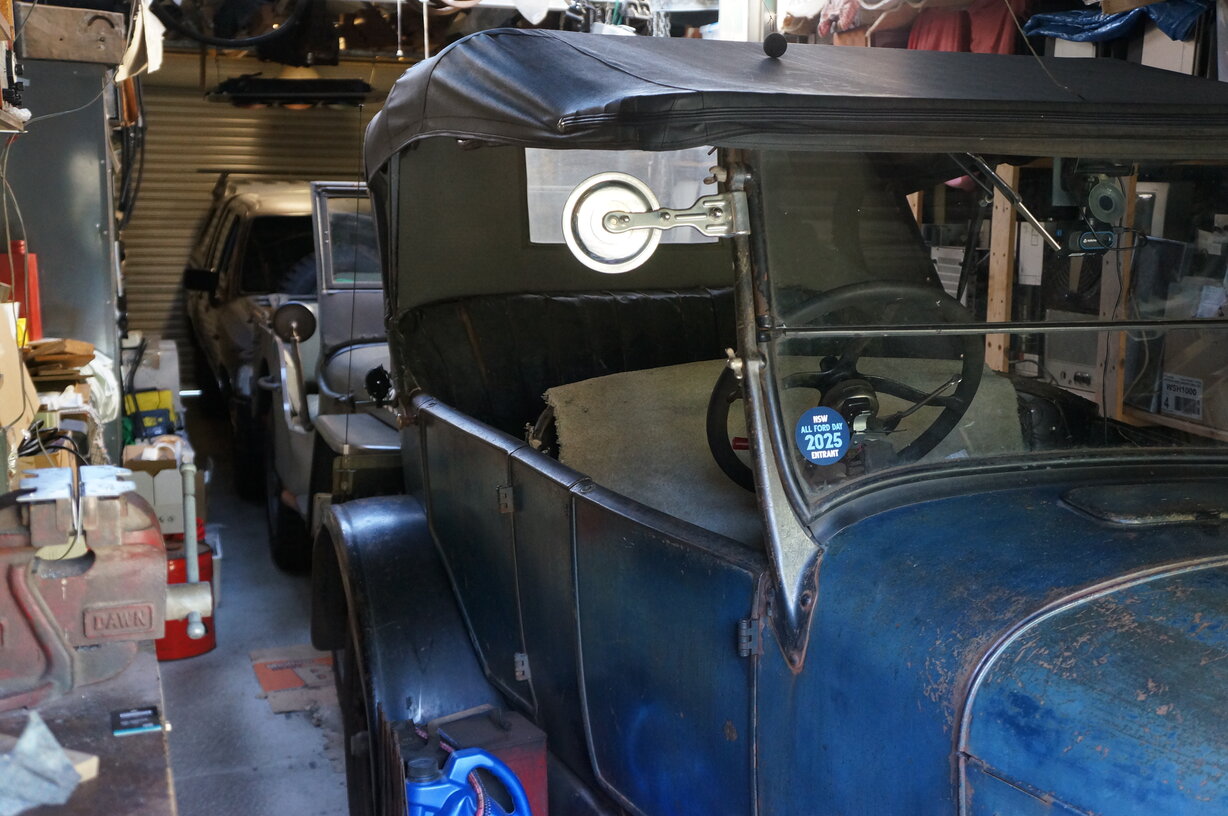
Like a can of sardines, they all fit in my garage.
One of the things I was keen to find out is, would all my three vehicles fit in my garage, which I'd only designed for two? As it turned out, the answer was yes! My calculations and measurements were surprisingly correct. There is only a few inches between each of them, and you can't walk between them. But, the important thing is they do fit, and the Hilux can still remain under cover. The only catch is, that's without the engine hoist and some other tools, which are kept at one end - I'll have to build another small shed for those.
Postscript 5/10/25: I've
had the Jeep for about six weeks now. It's been great to work on, with
good service access and a logical design. Parts availability is excellent.
An interesting thing is how quickly I
am ascending the learning curve with it. Much faster than with the Model
T - and I think this is largely because of my previous vintage car experience,
which I did not have prior to the Model T. The amount of YouTube
videos for Jeeps is impressive - something also I didn't have in my early
Model T days. For the most part, the manual I am using is the TM 9-803.
There are a few parallels between the Jeep and the Model T, which is no doubt part of my rapid connection with it. For example, no doors, windows, or seat belts. The petrol tank is under the seat. The engine is a three bearing flat head with long stroke. Electrical system is 6V. The windscreen can open out. The wipers are hand operated. The engine can be hand cranked. And of course, the Jeep is an open vehicle with a canvas top. Even the dashboard and cowl reminds me of a 1926-27 Model T.
Jeep Resources.